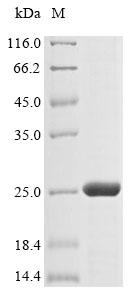Recombinant Actinia equina DELTA-actitoxin-Aeq1a gets produced in E. coli and comes with a 6xHis-tag at the N-terminus, which makes purification much easier. The full-length mature protein covers amino acids 36 to 214 and reaches a purity level above 85%, as confirmed by SDS-PAGE. This product is meant strictly for research purposes and maintains low endotoxin levels for reliable performance across different experimental setups.
DELTA-actitoxin-Aeq1a comes from the beadlet anemone Actinia equina. It's a toxin that appears to play a role in ion channel modulation. For researchers diving into neurophysiological studies, this protein may prove quite valuable—particularly when investigating how toxins work at the cellular level. It seems to be a key tool for anyone looking into ion channel function or studying how marine toxins affect cellular processes.
Potential Applications
Note: The applications listed below are based on what we know about this protein's biological functions, published research, and experience from experts in the field. However, we haven't fully tested all of these applications ourselves yet. We'd recommend running some preliminary tests first to make sure they work for your specific research goals.
Actinia equina DELTA-actitoxin-Aeq1a is a sea anemone toxin that likely requires precise folding, proper disulfide bond formation, and specific tertiary structure for its functional activity, such as ion channel modulation. The E. coli expression system may not provide the optimal oxidative environment for correct disulfide bond formation, which is critical for toxin stability and function. The N-terminal 6xHis-tag is relatively small and may cause minimal steric interference, but the probability of correct folding with functional bioactivity requires experimental validation, such as activity assays or structural analysis.
1. Protein Purification and Biochemical Characterization Studies
Basic biochemical and biophysical characterization can be performed, but results may not reflect native toxin properties if the protein is misfolded. Techniques like circular dichroism spectroscopy and dynamic light scattering can assess secondary structure and oligomerization, but disulfide bond formation needs verification. If correctly folded (validated), the protein is suitable for characterization; if misfolded (unverified), data may be misleading.
2. Antibody Development and Immunological Studies
This application is highly suitable as antibody development relies on antigenic sequence recognition rather than functional protein folding. The full-length mature protein provides comprehensive epitope coverage for generating specific antibodies. The high purity (>85%) ensures minimal contamination issues during immunization.
3. Protein-Protein Interaction Screening
This application carries a significant risk without proper folding validation. Toxin interactions with ion channels or other targets require precise tertiary structure and disulfide bonding. If correctly folded (verified), the protein may identify physiological binding partners; if misfolded/unverified, there is a high risk of non-specific binding or false negatives.
4. Comparative Toxin Structure-Function Studies
Meaningful comparative studies require native protein conformation and functional activity. If correctly folded and active (verified), the protein enables valid evolutionary and functional comparisons; if misfolded/inactive (unverified), analyses would yield misleading insights.
Final Recommendation & Action Plan
The E. coli-expressed DELTA-actitoxin-Aeq1a with a small His-tag may be folded correctly, but experimental validation is essential before functional applications. Begin with folding validation using disulfide bond analysis (e.g., mass spectrometry) and bioactivity assays (e.g., ion channel modulation tests) to confirm functionality. Application 2 (antibody development) can proceed immediately. Applications 1, 3, and 4 require rigorous folding and functional validation before use. For reliable toxin research, consider using eukaryotic expression systems or refolding protocols to ensure proper disulfide bond formation and native conformation.






